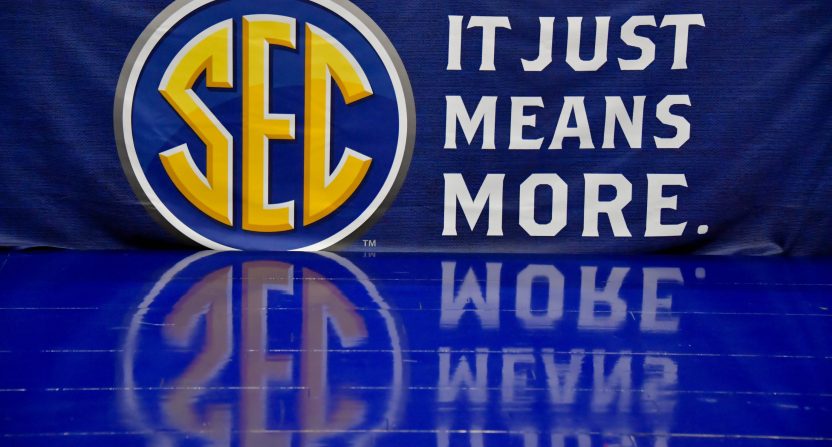2020 marked a difficult financial year for many colleges thanks to the COVID-19 pandemic, from lower ticketing, merchandise and food and beverage sales thanks to the limited to no fans allowed at games through the extra costs associated with regular COVID-19 testing and quickly-rearranged games through general university issues around tech costs for remote learning and/or declining enrollments resulting from a remote-only environment. That led to some conferences like the Pac-12 proposing the use of their media rights as collateral for a shared credit facility that their schools could access, and to some schools like Memphis making individual loan deals. But it turns out that the SEC has gone one step further, making a deal with Truist and Regions Bank to borrow against their future rights earnings from their lucrative first-tier contract with ESPN that’s set to start in 2024, and distributing that borrowed money to member schools immediately. Here’s more on that from Ross Dellenger of Sports Illustrated:
The league has distributed $23 million in supplemental revenue to each of its 14 members in an effort to help offset the financial impact of COVID-19, commissioner Greg Sankey confirmed to Sports Illustrated in an interview this week. The league is financing the distribution of $322 million by accessing future earnings from its multimillion-dollar media rights deal with ESPN that begins in 2024.
The SEC is the only conference to have announced additional distribution to its schools, and the amount is significant. The one-time additional revenue is more than half of the conference’s 2019–20 traditional revenue distribution ($45.5M per school). And still for some programs, the amount is a small portion of the revenue lost during the pandemic.
SEC schools lost an average of $45 million in revenue this past academic year, with some programs losing as much as $70 million, Sankey says. In addition to the lost revenue—much of it from football ticket sales—each SEC school spent at least $2 million on COVID-19 testing.
There are a couple of interesting elements to this. For one, it’s notable that the conference just went ahead and did this and distributed the money to the schools. While the Pac-12’s proposal of a shared facility that schools could access may sound better from a sense of “only those who need it will take it,” that seems problematic in college sports in particular; without a draft or free agency, recruitment is everything, and “Don’t go to that school! Their athletics department is in such bad shape that they needed a loan, while we didn’t” could be a decent negative recruitment pitch. (And the Freedom of Information Act aspects to college sports reporting make it pretty likely that any school’s decision would eventually come out.)
The SEC has conveniently avoided those conversations by just taking this loan against future conference rights and immediately handing it out to all schools. And all schools should have a use for this, especially as the money isn’t that restricted. Dellenger’s piece notes that “the expectation is these funds would be used to support athletes,” but like traditional media rights distributions, schools are free to use the money however they want. So this is money schools can use where it’s needed, and all of the SEC’s schools (like every school nationwide) could probably use some cash right now.
The latest
- Could NFL see next Saudi sportswashing controversy?
- ESPN and NBA have reportedly ‘essentially come to terms’ on deal that would keep Finals on ABC
- G/O Media sells The Onion to ‘Global Tetrahedron,’ ex-NBC reporter Ben Collins to serve as CEO
- Eli Gold on Alabama exit: ‘You can’t argue with city hall.’
In a lot of ways, this is really a classic example of when a loan can be good. The SEC’s schools are currently facing at least somewhat of a cash crunch from the circumstances of 2020. But their future earning potential from media rights is pretty assured, especially with this deal being with ESPN; ESPN parent corporation Disney will certainly be around and able to pay in 2024, something that might be more iffy if this was with a tech startup. And already having a media rights deal locked in is another advantage the SEC has over the Pac-12, which still has its rights up for grabs beyond 2023-24. Solidifying a new rights deal will be the key issue for new Pac-12 commissioner George Kliakoff, and a good deal there might give that conference similar flexibility going forward to what the SEC showed here; some issues with the Pac-12’s loan plan came from their future media rights not being locked down.
Thus, a conference-wide move like this from the SEC comes at the cost of some interest and some future deductions against rights fees in return for getting the money now. But getting that money now puts the schools in much stronger positions. And while this slightly diminishes what they’ll get over the last half of the decade, that seems worth it in return for not having to scramble now in the wake of overwhelming losses. This feels like a smart move from the conference, and one that may help its schools remain a dominant athletics force even amidst budget crunches.






